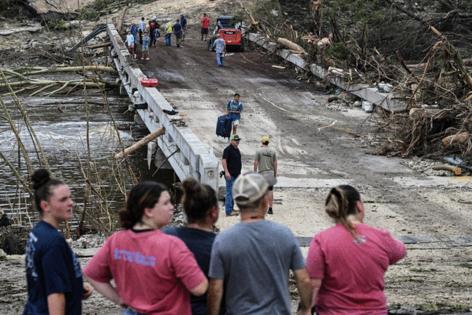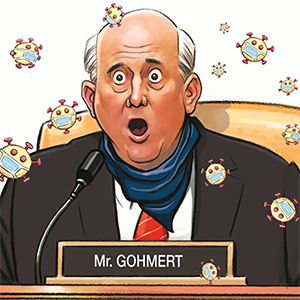Deadly floods reinforce challenges for Texas as crisis epicenter
Published in Weather News
Before dawn Friday morning, Dalton Rice went for a jog along the Guadalupe River in Kerrville, Texas. Rice, the city manager, finished his run around 4 a.m. as a light rain set in. An hour later, he began receiving emergency calls: the river had flooded out of control.
Torrential rains dumped into the Guadalupe, and in just 45 minutes, it surged about 26 feet (8 meters), according to state officials. Walls of water swept into camps and RV parks that were busy with holiday visitors. At least 70 people have died and dozens of children are still missing in the wake of the catastrophic flooding, which swept through an all-girls summer camp. With heavy rains still battering Texas on Sunday, politicians are raising questions over whether federal, state and local officials were adequately prepared.
Texas has been at the epicenter of extreme weather events in recent years — just in 2024, the state saw Hurricane Beryl knock out power to millions, a powerful windstorm that punched windows out of Houston skyscrapers and a massive wildfire that blazed across the Panhandle. The onslaught of disasters have come as warmer ocean waters and moister air — two results of global warming — provide added fuel to storms. At the same time, climate change has made it harder to predict the speed at which disasters can spin out of control, like in the Maui wildfires that killed dozens in 2023 and the “rapid intensification” that accelerated Hurricane Milton in Florida last year.
In Texas, the loss of life is so astounding that on Sunday search crews had to break down efforts into a grid pattern to recover bodies, Rice said during a press conference.
“We have increased our number of personnel that are navigating the really challenging shores along the bank line,” Rice said. “Our biggest focus is to making sure that we get families reunited with their loved ones.”
In the wake of the tragedy, some politicians are raising questions over the accuracy of weather forecasts issued before the disaster.
“The amount of rain that fell in this specific location was never in any of the forecasts,” Nim Kidd, chief of the Texas Division of Emergency Management, said in a briefing in which he also said the National Weather Service underestimated the severity of the storms.
The weather service, part of the National Oceanic and Atmospheric Administration under the Commerce Department, said that emergency management officials were briefed Thursday morning, flood watch was posted in the afternoon and, by 6:22 p.m. local time, forecasters were warning of flash floods and saying rain could fall at rates of more than 3 inches per hour.
There should be inquiries made into whether staffing cuts at the National Weather Service played a contributing role, Representative Joaquin Castro, a Texas Democrat whose district covers parts of San Antonio, said Sunday on CNN’s "State of the Union." The weather service has been under scrutiny since President Donald Trump took office, with staffing cuts and retirements hitting the agencies.
Still, Castro emphasized that there’s no clear evidence to show conclusively that the staff cuts impacted the outcome of forecasts.
At least 20.3 inches of rain fell in Streeter, Texas, about 100 miles northwest of Austin and 18 in nearby Hext. In some areas, flooding started around midnight on Friday morning.
Many residents in the area said they didn’t receive weather service warnings to their phones before 7 a.m. But reports are mixed. Andy Brown, a Travis County judge, said during a press conference that he met with survivors in one flooded area who told him they had received alerts from the National Weather Service at noon, before the event began, and then during the night.
Federal officials will look into whether more warnings could have been provided, Homeland Security Secretary Kristi Noem said in a briefing. At the same event, she also said there were federal resources “here on the ground since the beginning of this crisis started, since this weather event did start and even before it came, we were alerted.”
Climate change has driven more extreme rainfall around the world. A warmer atmosphere can hold more water, upping the odds of deluges like the one that struck Texas.
Scientists haven’t yet examined these floods for the fingerprints of climate change. A rapid analysis by Colorado State University climatologist Russ Schumacher shows the six-hour rainfall totals made this a 1,000-year event — that is, it had less than a 0.1% chance of occurring in any given year.
Storms are getting so devastating that insurers are struggling to keep pace with natural-catastrophe claims.
For Texas, this portends outsized consequences — the state alone accounts for roughly a third of all damages caused by extreme weather in the U.S. during the last 10 years.
The state is being walloped by extreme weather again and again. The onslaught illustrates a phenomenon that’s on the rise because of climate change: “compound events,” when the weather goes haywire in back-to-back or overlapping spells. Compound event s can be instances of the same kind of dangerous weather — one hurricane on the heels of another, say — or of different types, such as a heat wave coinciding with a drought.
From 1980 through 2024, Texas has logged 190 weather disasters costing $1 billion or more, according to the U.S. National Centers for Environmental Information. That’s the highest tally in the country. The U.S. stopped collecting data on these disasters after Trump started his second term.
Friday’s floods likely got a boost from the remnants of Tropical Storm Barry, which came ashore in Mexico last week and then sent moisture into Texas. Since 1913, 20 tropical storms, hurricanes or their remnants have caused 15 inches of rain or more across central Texas, the U.S. Weather Prediction Center said.
There were more flood warnings and watches across the heart of Texas on Sunday, with heavy rain continuing to fall through the day, said Allison Santorelli, a forecaster at the U.S. Weather Prediction Center. The weather may start to clear by Monday.
_____
(With assistance from Tony Czuczka and María Paula Mijares Torres.)
_____
©2025 Bloomberg L.P. Visit bloomberg.com. Distributed by Tribune Content Agency, LLC.







Comments